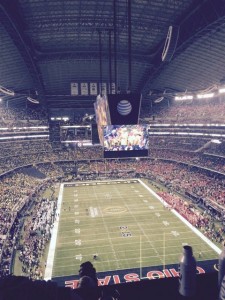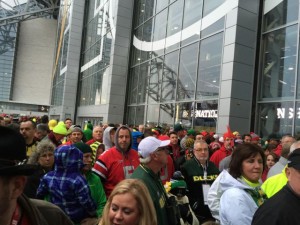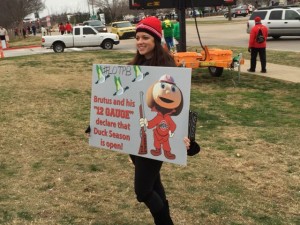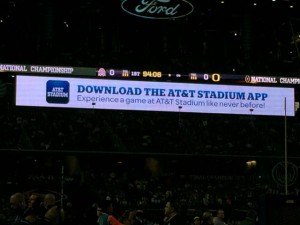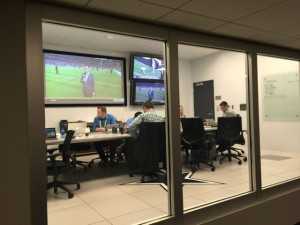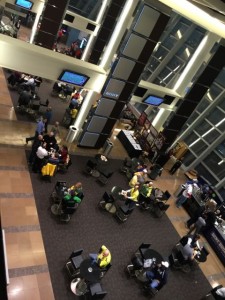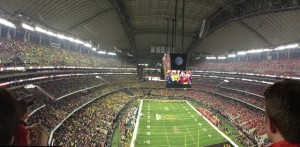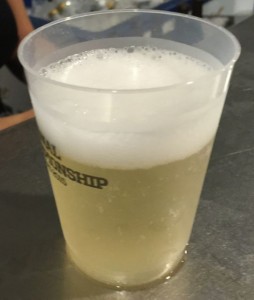The old saw that says “everything’s bigger in Texas” is not just a stereotype when it comes to wireless networking and AT&T Stadium. Though our visit was brief and we didn’t have the opportunity to do a deep-dive technology tour, the MSR team on hand at the recent College Football Playoff championship game came away convinced that if it’s not the fastest fan-facing stadium network, the Wi-FI and DAS deployments at AT&T Stadium sure are the biggest, at least the largest we’ve ever heard of.
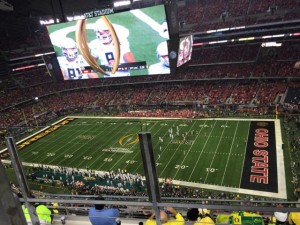
Inside AT&T Stadium at the College Football Playoff championship game. (Click on any photo for larger image) Credit all photos: Paul Kapustka, MSR
And in many ways we found, bigger is better, at least when it comes to staying connected inside one of the world’s truly humongous indoor spaces.
If you’ve not seen the stats, allow us to remind you that during the Jan. 12 championship game between the University of Oregon and THE Ohio State University the AT&T Stadium network carried more than 6 terabytes of wireless data, with almost 5 TB of that over the in-house Wi-Fi network. Another 1.4 TB was recorded being used by AT&T customers on the AT&T-hosted neutral DAS, which almost certainly carried another terabyte or two from other carriers on the system, who did not report any statistics. Any way you add it up, it’s the biggest single-day wireless data figure we’ve ever heard for a sports arena, professional or college, in any sport at any time.
Flooding the zone with more antennas and APs
How do you get such a big data number? One way is to make sure that everyone can connect, and one way to get to that point is to flood the zone with antennas and access points. Already the leader in the number of Wi-Fi access points and DAS antennas, AT&T Stadium got another 280 Wi-Fi antennas installed between Thanksgiving and the college championship game, according to John Winborn, CIO for the Dallas Cowboys. Some of those antennas, the staff said, were housed in new under-the-seat enclosures that AT&T’s Foundry designed somewhat specifically for use in the lower bowl of AT&T Stadium, which like other stadiums had previously had issues getting connectivity to seats close to field level.
According to Winborn, the AT&T Stadium now has more than 1,600 Wi-Fi APs in use for football games, and 1,400 antennas in its DAS network. By comparison, Levi’s Stadium in Santa Clara, Calif., perhaps the newest and one of the most technologically savvy venues out there, has 1,200 Wi-Fi APs and 700 DAS antennas in its deployments. Winborn also said that the antenna/AP number at AT&T can also scale up as necessary, especially for events that use up more of the building’s space, like the Final Four basketball tournament held there last spring.
“We scaled up to 1,825 [Wi-Fi] antennas for the Final Four last year,” said Winborn in a recent email, where he guessed that the venue might deploy up to 2,000 Wi-Fi APs when the Academy of Country Music Awards holds its yearly event at AT&T Stadium on April 19.
Hiding Wi-Fi APs an aesthetic priority
For all the extra numbers, one thing we noticed in walking around the building on Jan. 12 was that seeing an exposed Wi-Fi AP is about as common as seeing an albino deer. When we asked Winborn what the toughest thing was about network deployment in the venue, he responded quickly: “Finding ways to hide the APs so Jerry [Jones] doesn’t see them.”
With the price-is-no-object Jones on one side, and AT&T’s corporate image on the other, it’s clear there aren’t too many budgetary concerns when it comes down to spending more to make the network work, or look, better. Put it this way: You are never likely to have a “no signal” problem in a building that has on its outside an AT&T logo the size of the moon, and where AT&T CEO Randall Stephenson can be found wandering around the suite level during big events.
Though the immense space could probably be covered by fewer antennas, it’s worthwhile to remember that when the building was built and opened in 2009, it wasn’t designed with high-speed networking in mind. That means that almost all of the Wi-Fi and DAS deployments are a retrofit, including the ingenious circle of Wi-Fi antennas halfway up the seating bowl, which are covered by a tented ring of fiberglass designed and built specifically for the stadium.
According to Winborn the Wi-Fi network is supported by its own 2 GB backbone, with separate backbones in place for media networks and stadium application use. Winborn also noted that the stadium network runs 3,500 TVs via the Cisco StadiumVision system. Other records from this season include a peak concurrent Wi-Fi user mark of 27,523 (set at the Lions playoff game) and 38,534 unique Wi-Fi connections, that mark set at the season opener against the San Francisco 49ers.
Performance solid, even at rooftop level
So how fast are the Wi-Fi and DAS networks? In our limited testing time at the CFP game, we found solid connections almost everywhere we tried, including outside the stadium while we (freezingly) waited for the doors to open. Just outside the main ticket gate, we got a Wi-Fi signal of 23.93 Mbps on the download and 39.67 Mbps on the upload. At the same location a Verizon 4G LTE device got a 5.93 Mbps download speed, and a 2.59 Mbps upload speed, but it’s unclear if that was on the stadium DAS or just on the local macro network.
When the doors finally opened at 5:30 p.m. (no idea why Jerry kept us all out in the cold all afternoon) we went inside and got solid connections inside the foyer of the pro shop — 18.23/21.74 on Wi-Fi, 21.05/14.84 on an AT&T 4G LTE device, and 12.65/4.61 on a Verizon 4G LTE phone. (It’s worthwhile to note that all our Wi-Fi speeds were recorded on the Verizon device, a new iPhone 6 Plus.)
Down in our field-level suite, where we were the guests of AT&T, we got marks of 19.43/25.31 on the Wi-Fi, 7.35/11.04 on AT&T 4G and 5.71/4.05 on Verizon 4G. An interesting note here: When Oregon scored a touchdown on its opening drive, we took another Wi-Fi speedtest right after the play and got readings of 4.38/7.79, suggesting that there were many Ducks fans communicating the good news.
Later during the game we wandered up to the “Star Level” suites (floor 6 on the stadium elevator) and got a Wi-Fi mark of 11.57/30.51, and 19.31/13.46 on AT&T 4G. The only place we didn’t get a good Wi-Fi signal was at the nosebleed-level plaza above the south end zone, where we weren’t surprised by the 1.41/1.98 Wi-Fi mark since we didn’t see any place you could put an AP. We did, however, get an AT&T 4G signal of more than 7 Mbps on the download in the same location, meaning that even fans way up at the top of the stadium were covered by wireless, no small feat in such a huge space.
Bottom line: Network in place for whatever’s next
If there is a place where AT&T falls behind other stadiums, it’s in the synchronization of network and app; since it wasn’t built with food delivery in mind, it’s doubtful that AT&T will match Levi’s Stadium’s innovative delivery-to-any-seat feature anytime soon. And even though AT&T Stadium is dominated by the massive over-the-field TV set, fans at the CFP championship game were left literally in the dark during questionable-call replays, since they weren’t shown on the big screen and aren’t supported in the AT&T Stadium app.
Why have an 80-yard wide TV if you dont use it to show replays?
— paulkaps (@paulkaps) January 13, 2015
What could be interesting is if the technology demonstrated by AT&T at the big college game – LTE Broadcast, which sends a streaming channel of live video over a dedicated cellular link – becomes part of the AT&T Stadium repertoire. From experience, such a channel could be extremely helpful during pregame events, since many fans at the college championship were wandering around outside the stadium unsure of where to go or where to find will-call windows. A “pre-game info” broadcast over LTE Broadcast could eliminate a lot of pain points of getting to the event, while also introducing fans to the network and app for later interaction.
At the very least, AT&T Stadium’s network alone puts it in at least the top three of most-connected football stadiums, alongside Levi’s Stadium and Sun Life Stadium in Miami. Here’s looking forward to continued competition among the venues, with advancements that will only further improve the already excellent wireless fan experience.
More photos from our visit below. Enjoy!
